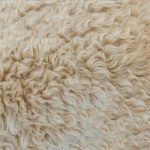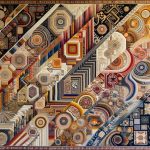Did you know that some of the earliest known textile patterns date back to the Mesopotamian era, around 5000 BCE, and often depicted mythological symbols? As you trace the evolution of textile patterns, you'll uncover how various cultures have left their mark on this art form, from medieval European heraldic designs to Renaissance brocade and damask techniques. Discover how Oriental influences and the Industrial Revolution further transformed fabrics, leading to modern trends like Art Deco and contemporary styles. Let's explore how these patterns have served as both artistic expression and societal commentary through the ages.
Table of Contents
Key Takeaways
- Ancient textiles from Mesopotamia and Egypt featured intricate weaves and symbolic motifs using natural fibers like wool and flax.
- Medieval European textiles incorporated heraldic symbols and religious themes, reflecting social status and theological messages.
- Renaissance innovations introduced advanced weaving techniques like brocade and damask, allowing for more intricate and vibrant designs.
- The Industrial Revolution's mechanized weaving techniques improved efficiency and democratized access to luxurious fabrics, though it devalued artisanal craftsmanship.
- Contemporary textile patterns leverage digital printing and 3D weaving, blending traditional motifs with modern minimalist and maximalist aesthetics.
Ancient Textile Patterns
Ancient textile patterns reveal the rich cultural heritage and artistic ingenuity of early civilizations. By delving into Mesopotamian textiles, you uncover a world where intricate weaves weren't just functional but also a reflection of their sophisticated craftsmanship. These early artisans employed advanced techniques to create textiles that showcased geometric and figurative designs, reflecting their society's complexity and technological prowess. You'll find that Mesopotamian weavers used natural fibers like wool and flax, skillfully transforming them into durable and decorative fabrics that have stood the test of time.
Similarly, Egyptian fabrics are a treasure trove of symbolic motifs, each carrying profound meanings tied to their cultural and religious beliefs. The Egyptians were masters of linen production, and their textiles often featured elaborate patterns depicting gods, pharaohs, and various mythological symbols. Understanding these motifs provides you with insight into their worldview and the reverence they held for their deities.
Medieval European Designs
When you explore Medieval European designs, you'll notice the strong influence of tapestry and heraldry in textile patterns.
Religious symbolism frequently appeared in fabrics, reflecting the era's deep spiritual focus.
Ornamental motifs and intricate patterns added a rich visual texture, making these textiles both beautiful and meaningful.
Tapestry and Heraldry Influence
Medieval European tapestry designs often drew heavily from heraldry, incorporating intricate coats of arms and family crests into their patterns. This connection between tapestry and heraldic symbolism wasn't just aesthetic; it was a means of communicating lineage, alliances, and social status. When you study these tapestries, you're not just looking at fabric; you're decoding a visual language that conveyed power and identity in Medieval Europe.
The revival of tapestry in the late Middle Ages saw a flourishing of these heraldic motifs. As you examine the craftsmanship of these textiles, you'll notice the meticulous attention to detail in the weaving of symbols like lions, eagles, and shields. These elements weren't randomly chosen; each symbol had a specific meaning and was used to tell the story of the family or individual it represented.
Religious Symbolism in Fabrics
Religious themes in Medieval European fabric designs often depicted biblical stories and saints, serving as both educational tools and expressions of faith. By weaving intricate scenes into tapestries and garments, artisans created a visual narrative that conveyed spiritual meanings and historical interpretation to the devout.
As you explore the symbolism exploration and cultural significance of these designs, you'll uncover how textiles became a medium for both reverence and instruction.
When investigating the spiritual meanings embedded in these fabrics, consider the following:
- Biblical Stories: Common motifs included the Nativity, Crucifixion, and Resurrection, each scene meticulously crafted to inspire contemplation and devotion.
- Saints and Martyrs: Fabrics often featured saints, their attributes, and martyrdoms, which not only honored these figures but also educated the public about their lives and virtues.
- Symbolic Imagery: Elements like the lamb (representing Christ) or the vine (symbolizing the Church) carried profound theological messages, enhancing the fabric's cultural significance.
Understanding these elements lets you appreciate how textiles were powerfully used to communicate and reinforce the religious tenets of Medieval Europe. This historical interpretation of fabric patterns reveals a rich tapestry of faith and artistry woven into everyday life.
Ornamental Motifs and Patterns
Ornamental motifs and patterns in European fabrics from the medieval era offer a fascinating glimpse into the aesthetic preferences and artistic ingenuity of the time. You'll notice intricate geometric shapes and elaborate floral motifs, each telling a story of cultural influences and artistic traditions. These patterns are more than mere decoration; they reflect the social and cultural fabric of medieval Europe.
Geometric shapes often found in medieval European textiles were inspired by tribal patterns and mathematical principles. These shapes brought a sense of order and symmetry, serving both aesthetic and symbolic purposes. Floral motifs, on the other hand, were rich in symbolism and often depicted local flora, emphasizing the connection between nature and art.
| Patterns | Description | Cultural Influence |
|---|---|---|
| Geometric Shapes | Symmetrical designs, often mathematical | Tribal patterns, mathematical concepts |
| Floral Motifs | Detailed depictions of flowers and plants | Local flora, nature-inspired |
| Combined Motifs | Mix of geometric and floral elements | Fusion of artistic and cultural influences |
Understanding these patterns helps you appreciate the depth and complexity of medieval European textiles. It's not just about the visual appeal; it's about the stories woven into every thread. By mastering the intricacies of these designs, you gain insight into the cultural and artistic heritage that shaped them.
Renaissance Innovations
During the Renaissance, textile patterns underwent significant innovations that reflected the era's artistic and cultural rebirth. You'd be amazed at how renaissance techniques revolutionized textile innovations, giving birth to intricate designs and luxurious fabrics. These historical fabric designs weren't just about aesthetics; they were deeply intertwined with the cultural influences of the time.
To truly appreciate the advancements, consider these key points:
- Renaissance Techniques: Artisans employed advanced weaving methods, such as brocade and damask, to create elaborate patterns. These techniques allowed for more complex and detailed designs, showcasing the era's ingenuity.
- Textile Innovations: The introduction of vibrant dyes and new weaving technologies enabled the creation of richer, more colorful fabrics. By combining these innovations, textile makers could produce fabrics that weren't only beautiful but also durable and practical.
- Cultural Influences: The Renaissance was a melting pot of ideas, with inspirations drawn from classical antiquity, nature, and burgeoning scientific discoveries. These elements were seamlessly integrated into textile patterns, resulting in designs that were both timeless and forward-thinking.
Oriental Influence
A significant shift in textile patterns emerged as Eastern motifs and techniques began to influence Western designs. You can trace this transformation back to the Silk Road, the ancient trade route that connected the East and West. Through this conduit, luxurious silks, intricate embroidery, and vibrant dyes from China, India, and Persia found their way into European markets. These imports didn't just bring new materials; they brought an entire philosophy of design that emphasized harmony, nature, and complexity.
As you explore this period, you'll notice how the cultural fusion of East and West resulted in a rich tapestry of patterns. Floral motifs, arabesques, and geometric designs became prevalent in Western textiles, a clear departure from the more rigid and simplistic medieval styles.
You'd see the meticulous craftsmanship in brocades, damasks, and tapestries, which often depicted scenes of exotic landscapes and mythical creatures.
Industrial Revolution Impact
You can't overlook the Industrial Revolution's impact on textile patterns. Mechanized weaving techniques revolutionized production, making intricate designs more accessible.
As mass production took hold, textiles became affordable, widespread, and diverse.
Mechanized Weaving Techniques
Revolutionizing the textile industry, mechanized weaving techniques drastically improved production efficiency and quality. With the advent of automated looms, you witnessed a transformation that had profound historical significance. These technological advancements allowed for intricate textile designs that were previously unimaginable.
Speed and Precision: Automated looms operated faster than any human could. You could produce intricate patterns at an astonishing rate, ensuring consistency and reducing errors.
Cost Efficiency: The mechanization reduced labor costs and minimized waste. You found that producing high-quality textiles became more affordable, making beautiful designs accessible to a broader audience.
Innovative Patterns: With the new machinery, you could explore complex patterns and textures that manual methods simply couldn't achieve. This innovation in textile design elevated the industry and satisfied a growing demand for unique fabrics.
Mass Production Effects
As the Industrial Revolution took hold, mass production reshaped the textile industry, making once-luxurious fabrics available to the general populace. You could now acquire intricate patterns that were previously the exclusive domain of the wealthy. However, this democratization came at a cost. Factory conditions were often harsh, with workers enduring long hours and unsafe environments. These conditions inevitably affected the design integrity and artistic quality of the textiles produced.
You must consider the economic implications of mass production. While it lowered the cost of textiles, making them accessible, it also led to a devaluation of artisanal craftsmanship. The market became flooded with lower-quality goods, and the emphasis shifted from unique, handcrafted pieces to standardized, mass-produced items. This shift had a profound impact on the artistic quality of textile patterns.
Despite these drawbacks, the industrialization of textiles brought about significant advancements. New dyes and printing techniques emerged, allowing for more vibrant and diverse designs.
Art Deco and Modernism
Art Deco and Modernism brought bold geometric patterns and sleek designs to the forefront of textile innovation. You'll notice how geometric shapes and bold colors became defining elements of the Art Deco movement. This period focused on symmetry and streamlined forms, creating textiles that exuded luxury and sophistication. Whether it was zigzags, chevrons, or sunburst motifs, the use of these patterns transformed fabrics into dynamic works of art.
Modernism, on the other hand, introduced abstract designs and a minimalist approach that emphasized function over form. You'd find textiles featuring clean lines and simplified patterns, often relying on a limited color palette to make a powerful statement. This era moved away from the ornate and embraced simplicity, allowing the intrinsic qualities of the materials to shine through.
To master these styles, keep an eye out for the following:
- Geometric Shapes and Bold Colors: Look for textiles with striking, repetitive patterns and vivid hues.
- Abstract Designs: Seek out fabrics with non-representational forms that challenge traditional aesthetics.
- Minimalist Approach: Opt for designs that prioritize simplicity and clarity, focusing on the essence of the material itself.
Post-War Trends
In the post-war era, textile patterns shifted towards more playful and experimental designs, reflecting the optimism and innovation of the time. You witnessed a bold break from the past, as fashion influences and consumer preferences began to favor vibrant colors and dynamic motifs. Floral prints, abstract shapes, and geometric patterns became popular, symbolizing a newfound sense of freedom and creativity.
Technological advancements played a pivotal role in this transformation. The introduction of synthetic fibers like polyester and nylon allowed for more diverse and durable fabrics. This innovation opened up endless possibilities for design aesthetics, enabling intricate patterns that were previously difficult to achieve. Screen printing and other modern techniques further revolutionized the industry, making it easier to produce detailed and colorful designs on a mass scale.
You also saw the influence of global cultures seeping into Western textile patterns. Inspired by international travel and cultural exchange, designers incorporated elements from African, Asian, and Latin American art. This eclectic mix enriched the textile landscape, offering a variety of choices that catered to different tastes and preferences.
Contemporary Styles
Building on the vibrant experimentation of the post-war era, contemporary textile patterns now embrace both minimalism and maximalism, reflecting a diverse range of aesthetic preferences. Minimalist designs, characterized by clean lines and subtle textures, cater to those seeking simplicity and elegance. This trend is often intertwined with sustainable fashion, emphasizing eco-friendly materials and ethical production methods.
Textile technology plays a pivotal role in advancing contemporary styles. Cutting-edge techniques such as digital printing and 3D weaving allow designers to push boundaries, creating intricate patterns that were once unimaginable. These innovations not only enhance the visual appeal of textiles but also improve their functionality and durability.
Cultural influences continue to shape contemporary textile patterns, offering a rich tapestry of global traditions and modern interpretations. Designers draw inspiration from various cultures, blending traditional motifs with contemporary aesthetics to create unique and compelling designs.
To fully appreciate contemporary textile styles, consider the following:
- Minimalist Designs: Focus on simplicity, quality materials, and sustainability.
- Textile Technology: Explore advanced techniques like digital printing and 3D weaving.
- Cultural Influences: Embrace the fusion of traditional and modern elements.
Frequently Asked Questions
How Did Textile Patterns Influence Social Status Across Different Eras?
Fashion trends frequently fueled class division. You'll see how symbolism and superior craftsmanship in textile patterns highlighted social hierarchy, setting apart the elite from the commoners, showcasing their status and sophistication throughout different eras.
What Role Did Trade Routes Play in the Spread of Textile Patterns?
You'll see how trade routes like the Silk Road facilitated textile exchange, driving globalization and pattern migration. These networks spread designs across continents, transforming local styles through a blend of cultural influences and shared techniques.
How Have Technological Advancements Impacted the Durability of Textile Patterns?
Technological advancements have greatly improved textile durability. You'll find that innovation in materials and techniques has enhanced sustainability, boosting both quality and functionality of patterns, ensuring they last longer and perform better in daily use.
Are There Any Endangered Traditional Textile Pattern Techniques?
Over 60% of traditional textile techniques are endangered. You must support preservation efforts and revival initiatives to maintain their cultural significance. Artisan communities hold the key to these crafts, ensuring they're passed down through generations.
How Do Cultural Festivals Influence Contemporary Textile Patterns?
Cultural festivals ignite innovation and creativity in contemporary textile patterns. They foster cultural exchange, inspiring designers to blend traditional techniques with modern aesthetics. You'll see vibrant, unique designs that honor heritage while pushing artistic boundaries.
- How Does Ring Spun Cotton Affect Garment Fit and Shape Retention? - August 13, 2024
- What Are the Challenges in Producing Ring Spun Cotton? - August 13, 2024
- Is Ring Spun Cotton Suitable for Plus-Size Clothing? - August 13, 2024






